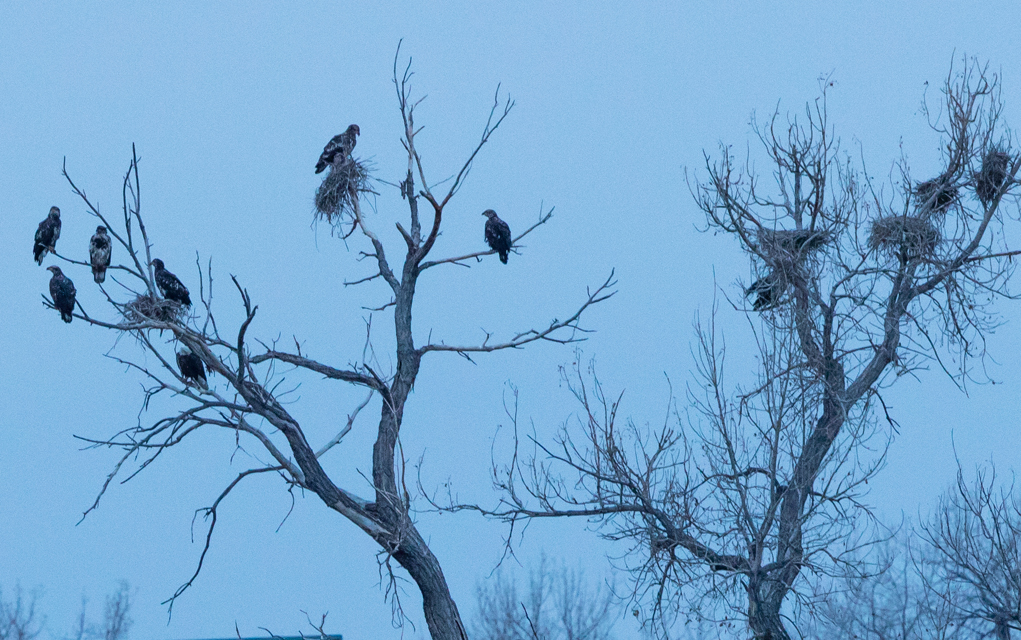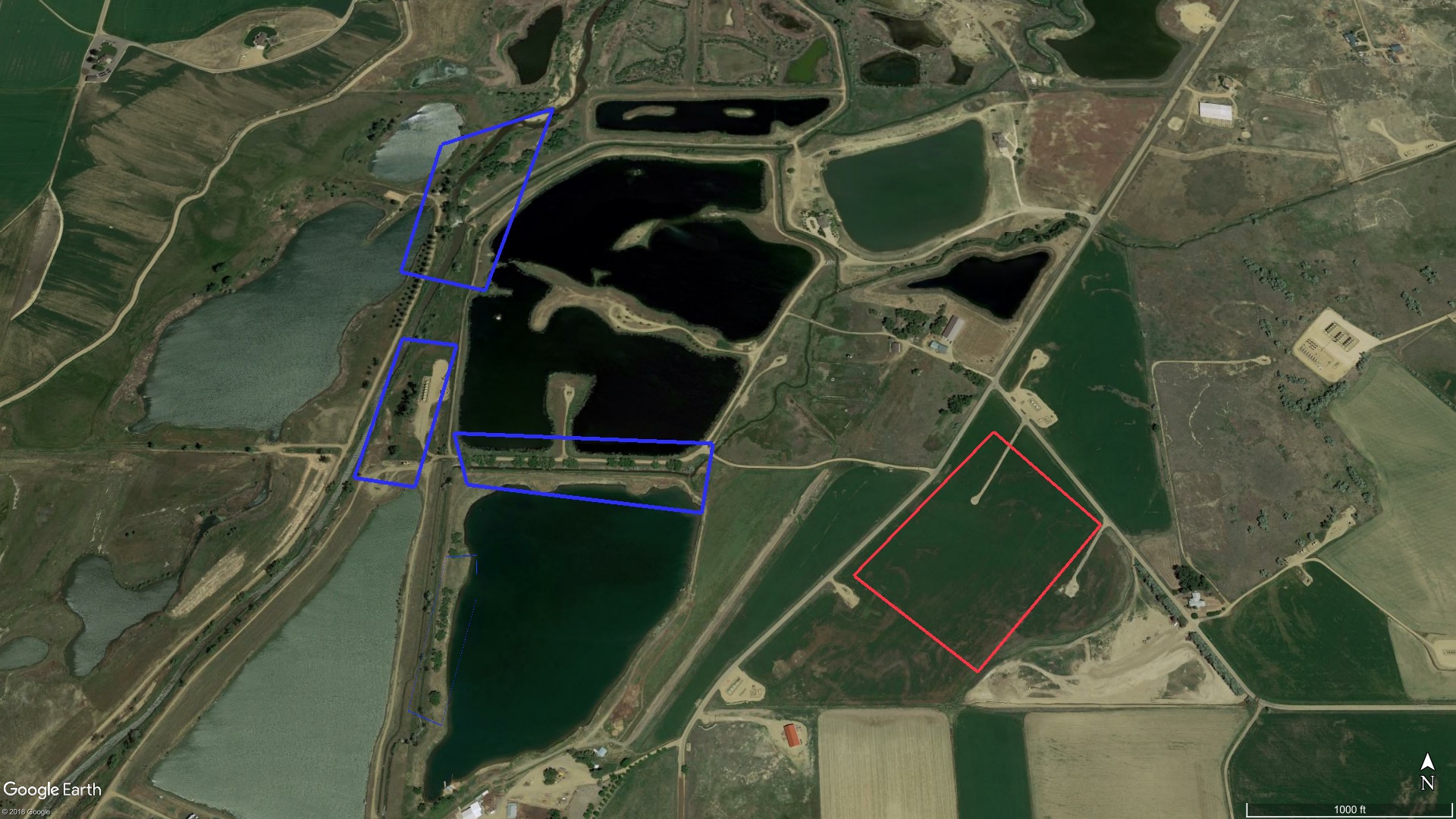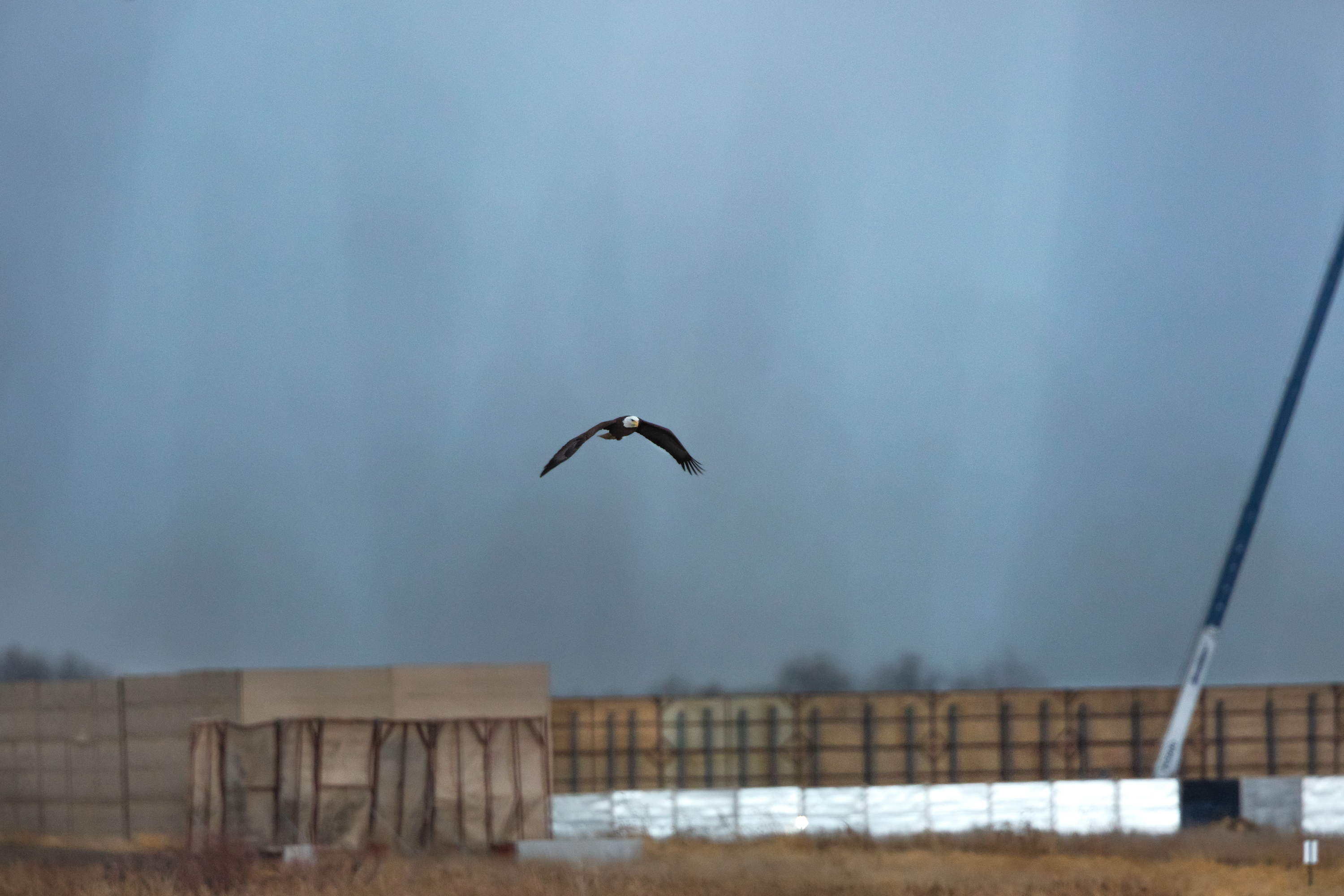
Just a few miles into Weld County, east of County Line Road, there’s a group of old-growth cottonwood trees along Boulder Creek in the middle of several quarry ponds surrounded by a meadow of hay. It’s near-perfect conditions for migrating bald eagles to roost for the winter, a place they can feed, forage and shelter during the short days and cold nights.
Volunteer researchers with the group Front Range Nesting Bald Eagle Studies (FRBNES) observed as many as 23 traveling bald eagles in 2017 roosting at the site, known as the middle Boulder Creek communal bald eagle roost. Within the last year or so, however, numbers have dwindled. Some winter days researchers see a few, maybe a dozen or so. But if there is any heavy machinery, lights, noise or drill rigs in the area, the count is generally zero. There are a few tanks near the trees, a pipeline going in up the creek, and rigs have been plugging wells nearby.
“What we see is when those rigs are around, there are no eagles there,” says Dana Bove, a retired federal geologist who now spends his time observing and documenting bald eagles in Boulder and Weld counties with FRNBES.
And this kind of disturbance in the area is only likely to worsen, Bove says, with Crestone Peak Resources’ plan to put in 22 wells about one-third of a mile to the east of the historic winter roost. The company’s application was approved by the Colorado Oil and Gas Conservation Commission (COGCC) in September 2018, although work has yet to begin at the site.
It wasn’t so long ago that spotting a bald eagle in Colorado was a rare event. Although populations in the 1800s are said to have reached 100,000 or more across the U.S., by the 1970s, there were fewer than 450 nesting pairs, resulting in U.S. Fish and Wildlife (FWS) listing bald eagles as an endangered species in 1978. Only recently bald eagle populations have rebounded, causing the U.S. FWS to officially delist the bird in 2007. Other federal protections, like the Bald and Golden Eagle Protection Act (BGEPA) and Migratory Bird Act, however, still protect the bird. Along with killing, capturing, selling or purchasing of bald eagles or their parts, it is federally illegal to agitate the birds to the extent that it interferes with their “normal breeding, feeding or sheltering behavior.”

Colorado also has state laws that prohibit the direct killing or harassment of bald eagles, or destroying their nests. And in 2008, Colorado Parks and Wildlife (CPW) developed guidelines for buffer zones and seasonal closures around nests and wintering bald eagles in order to protect the bird. The hope is that these recommendations, which aren’t enforceable by law, may prevent reactions in eagles “as subtle as elevated pulse rate or as obvious as vigorous defense or abandonment” of roosts or nests, according to the recommendations.
In order to prevent the impacts of such disturbance, which may not be immediately evident, CPW suggests a half-mile buffer when there’s a clear line of sight between development and the roost, with no human encroachment from Nov. 15 to March 15.
When it comes to oil and gas development, a roost within the half-mile buffer is supposed to trigger a wildlife consultation with CPW as part of a company’s application to the COGCC, but that didn’t happen in the case of the proposed Crestone well pad, known as Dream Weaver.
According to FRNBES maps, the middle Boulder Creek communal bald eagle roost is one-third of a mile from Dream Weaver, and Bove has been submitting maps and data from the roost to CPW for several years. “We feel that the best way to protect and try to conserve [bald eagles] is by supplying rigorous scientific information and data,” he says. “We’ll give our information to CPW, we’ll give it to whomever can utilize it.”
There are also a few other roost areas nearby, although outside the buffer.
According to CPW, when the COGCC considered the Dream Weaver application, the buffer for this particular roost was not accurately drawn on the map the agency uses. “It has since been corrected,” CPW Area Wildlife Manager Kristin Cannon says via email.
Brandon Marette, northeast region energy liaison with CPW, says CPW updates its wildlife maps every month or so. He reviews every application for drilling that comes through the COGCC, comparing the proposals to CPW’s maps of sensitive habitat. He says in 2018, he reviewed 744 location assessments for oil and gas development, notwithstanding another 301 for other energy projects like solar, wind, etc. Still, for whatever reason, the buffers weren’t accurate when it came to reviewing the Dream Weaver pad, and the COGCC approved Crestone’s application without a wildlife consultation in September 2018.
According to Travis Duncan, spokesman from the Department of Natural Resources (DNR), which oversees both CPW and the COGCC, the site was approved “in accordance with COGCC rules, and will not be suspended or revoked,” despite the mapping mistake.
“The permits were issued following public comment periods during which none were received,” Duncan’s email continues. “COGCC continues to work with the operator to determine what voluntary measures they will take to avoid or minimize impacts to the birds.”
Bove says neither he, nor FRNBES, was aware of Crestone’s application until after it was approved, despite several requests to CPW and COGCC asking about it. Given the amount of time the group spends in the area, and the collaborative work they do with CPW, Bove says, he just figured someone would tell him about the application in time to comment. “Our group is spending all this time working in that area and CPW and COGCC know that. How are you supposed to be made aware of something like that?” he says.
Regardless, he found out about it too late, after the public comment period had ended and the pad had been approved. And for months FRNBES has been trying to get the site reconsidered in order to protect migrating eagles, who use the roost in the winter.
“The information wasn’t there, but it is there now, and COGCC is still leaving it entirely up to Crestone to voluntarily come up with their plan of action,” Bove says. “The way I see it is oil and gas gets their way. They run the game out there … in terms of wildlife, they run the damn game.”

Bridget Ford, a community relations advisor with Crestone, says via email that when the company was made aware of the eagles near the Dream Weaver site, representatives met with the Town of Frederick, CPW and wildlife biologists to “ensure compliance.”
“The additional monitoring showed 1-2 eagles in the area and it was confirmed that eagles were roosting further north outside of our area of disturbance,” Ford says in an email.
Cannon with CPW also says eagles haven’t been observed using the roost site for several weeks, although Bove says his team saw nine as recently as Feb. 5 in trees that are part of the Middle Boulder Creek roost that lie just outside the half-mile buffer.
At this point, construction on the well site isn’t expected until after the winter roosting season ends on March 15, Ford says, but the company has agreed to limited hours of operation (between 9 a.m. and 3 p.m.) if they need to access the site before then.
“Again, that is unlikely to happen given our current operations timeline,” she says.
Although CPW’s 2008 recommendations advise no disturbance within a half-mile of a roost during winter months, there is a provision allowing maintenance activities between 10 a.m. and 2 p.m. during winter roosting. Cannon says the extended time (9 a.m. to 3 p.m.) agreed upon with Crestone “is more appropriate for this time of year” when the days are longer than in the dead of winter. The Town of Frederick also included these hours in its special use permit for the project, according to planning manager Jennifer Simmons.
But, there’s always the question of next winter, and the one after that, and the one after that.
“The company has told us that work on this well should be completed by the middle of next year so it should only be an issue relative to this roost through next winter,” Cannon with CPW says. “We will meet with them sometime around late summer or early fall to discuss mitigation for next winter. For the long term, we generally ask all companies to restrict maintenance work on wells to protect nests and roosts to outside of our recommended buffers.”
And given that CPW’s recommendations aren’t enforceable, there’s not much more the agency can do than ask, which, Bove worries, may not be enough to help the birds.
“As defined under the Bald and Golden Eagle Protection Act, what we’re seeing in terms of behavioral changes with these birds are consistent with the take of eagles,” Bove says. According to the GBEPA, “take” includes disturbing the birds, which is further defined as anything that causes injury or interferes with normal breeding, feeding or sheltering behavior that could impact productivity or result in nest abandonment.
“COGCC’s continued upholding of Dream Weaver approval completely ignores CPW’s recommended restrictions, which state that such a project will likely disturb federally protected eagles, and thus by ignoring CPW’s recommendations, the state of Colorado and COGCC is sanctioning a likely violation of a federal law,” Bove continues.

Although the more restrictive BGEPA laws are enforceable by U.S. FWS, Bove says the law is toothless. When he’s contacted law enforcement in the past about encroaching development’s threat to eagles and their nests, the response has been limited.
So the question for Bove and the researchers at FRNBES remains: Will Crestone’s voluntary efforts to mitigate impact be enough to protect the birds?
“The middle roost is already often-disturbed, and rather than making for more disturbance, it should be even further protected,” Bove says. “The noise and the lights are going to be the major issue.”
Recent studies show that anthropogenic noise, emitted from the oil and gas compressors, have caused increased stress hormones in nearby bird populations, resulting in PTSD-like symptoms. Such stress adversely affects reproduction and survival rates. The noise also jeopardizes birds’ hearing, and their ability to detect danger.
In early December 2018, FRNBES noticed an uptick of bald eagles at the roost consistent with winter traveling patterns. On Dec. 2 there were as many as 13 different eagle sightings in the roost at dusk. Several days later, there were almost none, coinciding with heavy equipment and lights along the roads. One afternoon while a FRNBES researcher was observing, a couple of heavy equipment trucks drove down the road north of the roost and about five minutes later, all four eagles at the site began “vocalizing” before leaving and flying north.
“They’re operating towards the end of the day with lights right near this roost area and you can see what happens to the count,” Bove says. “That [Dream Weaver] pad doesn’t belong there. … They just need to move that thing farther away within CPW’s restricted buffer areas.”
Not only is the winter roost a concern for Bove, he says there is also a pair of nesting eagles close by that uses the cottonwood trees at the roost site year-round. “Maybe this roost isn’t active in the summer, but this pair uses these perches to hunt and hang out all year long,” he says. “You see them there all the time.”
Through their lawyer, FRNBES is formally requesting that the COGCC reconsider the permit, and look at alternative sites outside the half-mile buffer, with appropriate consultation with CPW.
Whether or not the COGCC considers this request remains to be seen, but so far the Department of Natural Resources has been adamant that the Dream Weaver permit will not be reconsidered. Which raises a major question, according to Bove: “Is COGCC willing to take on the liability of going against their own cohorts who are saying that you could likely disturb eagles that are federally protected?”
Read Boulder Weekly’s update on the middle Boulder Creek communal bald eagle roost here.
Clarification: The story has been updated to reflect the bald eagles observed on Feb. 5 were outside the half-mile buffer recommended by CPW.















